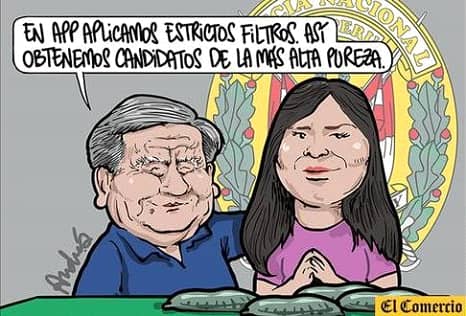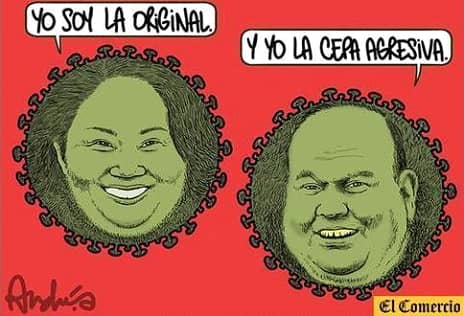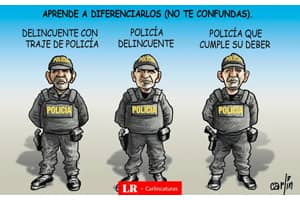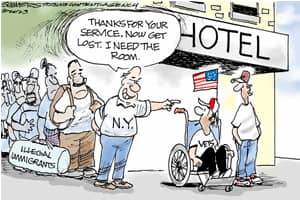Tabla de contenidos
I usually read this type of texts, although I recognise that due to their structure and purpose, they are usually quite boring, but I am interested in what is done in other countries and how it is analysed from an academic point of view. This is a research work to obtain a bachelor's degree in Professional Graphic Design at the Universidad de Peruana de Ciencias Aplicadas.
As it was under CC license, I decided to leave it here.
Only the chapter referring to the vignettes is reproduced here, you can consult the complete document, methodology, bibliography and all that in its source.
Item Type: info:eu-repo/semantics/bachelorThesisAuthors
: Chirinos Ruiz, AranzaPublisher
: Universidad Peruana de Ciencias Aplicadas (UPC)
Rights info: eu-repo/semantics/openAccess; AttributionNonCommercial-ShareAlike 4.0 InternationalItem
License: http:
//creativecommons.org/licenses/by-nc-sa/4.0/Link to Item: http://hdl.handle.net/10757/658752
General visual analysis of the vignettes
Each of the six (6) vignettes analysed, produced by the illustrator-humorists Carlos Dávila and Andés Edery, were constructed by means of different semiotic-discursive resources understood in turn as modes, which, through an observation guide, are deciphered taking into account the elements presented by Gil and Cáceres (2008).
From the analysis of the political cartoons of the aforementioned humorists, it can be seen that the illustrations have very similar denotative characteristics (external structure) in common. With regard to the verbal elements, the text is present in certain cases as a support for understanding; however, in the vast majority of cases, they remain in the background, with the iconic element being more striking
However, the use of paralinguistic elements through text balloons reinforces the message. On the other hand, it is worth highlighting that, in relation to the verbal component of the cartoon, Andrés Edery's humorous message is characterised by a constant criticism of the political discourse.

Figure 2. Source: El Comercio newspaper, 25 January 2021
This particularity, unlike the category of legitimation, is characterised by attacking political power and not defending it (Zavitsanou, 2016); while, in the case of Carlos Dávila, it stands out for its criticism of the behaviour of the presidential candidates. Furthermore, with regard to the image, the aforementioned illustrators rely heavily on iconic elements, their cartoons reflect chaos -as a symbol-, which is additionally applied to the behaviour of the characters depicted
Also, it is the figurative or symbolic construction which superimposes the image on the exposed behaviour, which suggests a certain legitimacy in the
vignette. It can also be seen that Carlos Dávila makes use of a particular iconic element, known in artistic language as "monkeys", which contribute to the representation of each character in a much more interpretative concept, always maintaining a sober aesthetic.

Figure 3. Carlos Lavida - Source: Diario Gestión, 8 June 2021
In relation to colour, they use it in such a way that it generates impact, or on the contrary, that it goes unnoticed. There are vignettes where colour predominates, as in the case of Andrés, who mostly prefers and uses opaque tones, but always adding a saturated iconic colour as an accent that attracts attention and hierarchises the vignette, with the aim of generating aggressiveness, disagreement, fear, insecurity, etc. While in the case of Carlos Dávila, he uses slightly saturated tones, which remain in their natural state (more pure and luminous); but above all, he uses mostly warm tones, in order to convey the message with much more energy.
In general terms, both illustrators make use of symbolic colours so that the message conveyed in their cartoons is interpreted indirectly. As an example, and depending on the context, red could symbolise danger and white, peace.

Figure 4. Carlos Lavida - Source: Diario Gestión, 15 February 2021

Figure 5. Andrés Edery - Source: El Comercio newspaper, 9 March 2021
Now, regarding the denotative (internal structure), the dialogues and/or linguistic resources in most of Carlos Dávila's cartoons are scarce, as he uses short phrases or exact words that express delimited messages, while Edery goes a little deeper into the texts to generate a more open dialogue
Nevertheless, the language applied is concrete and sarcastic in purpose, with the intention of accentuating the caricature. Both use their own judgement to the disbelief of the readers. On the other hand, with regard to their critical stances, both show impartiality and comply by neutrally exposing the political events that took place during the 2021 election campaign.
With regard to the purpose or objective of the graphic pieces, in both cases the intention is to generate political participation on the part of the recipients, but, above all, to make them laugh, evidently without seeking to support or publicise any campaign and/or ideology. Similarly, the intention is to deal with themes that are of interest to the public in order to generate awareness and therefore, in one way or another, a change in society; however, at present, both authors do not consider this to be very likely.
Metaphor and hyperbole as rhetorical devices
The use of rhetorical resources in the case of humour, both graphically and textually, are the most suitable, as they intensify the expression of a certain vision of the facts, either by ridiculing them, or by seeking new meanings that are emitted from the new effects of meaning (Chamorro, 2005)
The caricaturist applies different rhetorical figures, which according to Font (1981), is a non-conventional way that characterises a certain message and seeks the emotive persuasion of the receiver, which emanates from literature and can be in the iconic member of the image as well as in the verbal.
A quite notorious quality in the vignettes analysed is the rhetorical and humorous use of metaphor and hyperbole. This is where the figurative -connotative- language mentioned by Acaso (2006) comes in, which varies according to the interpretation made by the reader. Firstly, following the analysis sheet, a large percentage of the vignettes are connotatively characterised by metaphor.

Figure 6. Carlos Lavida - Source: Diario Gestión, 21 April 2021
The metaphor, according to the RAE, is a trope that consists of transferring the firm sense of voices to a figurative one, by virtue of a tacit comparison; in visual terms, it is the resource that attempts to express a certain specific idea in order to make it more memorable and lasting in the mind of the receiver (Bassat, 1994)
Also, it could be said that it impresses and communicates in a better way. In the case of humour cartoons to express certain political messages, the aforementioned figure of speech is appropriate, as these media need the synthesis of the message and depend on a quick understanding - visually - by the reader, and it is here where the role of textual dialogue has been reduced to a minimum, with the iconic element being the main one.
On the other hand, the metaphor helps to establish a complicity between the graphic piece and the receiving public, who take a position in the development thanks to the fact that the cartoon requires their participation for a better interpretation of the rhetorical figure used, also expressing the opinion of the humorist regarding the subject, without leaving behind the objective: persuasion of the public and to generate reflection together with the reader
and to generate reflection as well as entertainment. As can be seen in Figure Nº6, both characters are metaphorically represented as school supplies, since during the presidential elections of 2021, one of the political parties - Perú Libre - had as an iconic campaign element a pencil, which would come to be manipulated by the other elements - eraser and cutter - implying that the political party led by Pedro Castillo, who is the current president; would ultimately be controlled by Vladimir Cerrón for being the one giving the orders at the time.
Another point is the use of hyperbole in the cartoon. This concept, established by Acaso (2000), tells us that we are dealing with hyperbole when an exaggeration is explicitly seen in some element of the image. According to the RAE, it is the exaggeration of a circumstance, story or news item. In the graphic case, hyperbole is the figure of speech whose purpose is to argue by means of exaggeration - written or visual - in the search for the audience's adhesion (Pinheiro, 2013). The use of this tends to capture the reader's attention much more; therefore, it will last in some way or another in their memory.

Figure 7. Carlos Lavida - Source: Diario Gestión, 17 May 2021
As can be seen in Figure Nº7, the exaggeration of making a fake fight between two people wearing uniforms with colours representing the political parties "Perú Libre" and "Fuerza Popular", due to the competition that existed between the two presidential candidates during the second round of elections in 2021.
For cartoonists, a cartoon has achieved its objective when the receiver captures the real message that is given; and this, for the most part, is achieved through rhetorical figures that help to better understand the subject, and this is the moment when an encounter between the reader and the author takes place.
Readers' perceptions of the vignettes
After having applied the survey to the readers of the selected sample, it was proposed to identify their opinion regarding the different aspects related to the humorous message of the cartoons of Carlos Dávila and Andrés Edery referring to the last electoral campaign of the year 2021; therefore, accurate information was obtained to understand in a qualitative way the orientation exercised by the political cartoons exposed in the public opinion represented by the 100 selected readers.
Regarding the results, it can be mentioned that the opinion of the surveyed citizen considers that the graphic humorous messages represent the voice of all Peruvians who judge the behaviour of the characters who have political power, as in this case of the presidential candidates who have already had political references before; likewise, through the critical component of their graphic pieces, the humorists are able to incite to take a position on the events occurred in politics with respect to public opinion, also generating in the reader a state that alerts, reflects, and leads to a more opinionated and critical state
In this way, the dialogue between the recipients - mostly discussions - is achieved in the digital media, which are increasingly present today and help to speed up the message. On the other hand, the humorous message fulfils in the public's opinion an informative function, in which it makes the reader aware, in a graphic way, of aspects that probably had not been noticed, generating critical awareness about them and aligning with the author's position
Also, it is identified in the reader's opinion, that political cartoons increase in some way or another their interest in politics; and finally, they identify that political illustrators remain in a vigilant state of vigilance of the facts linked to the country's political characters and seek precise opportunities to express, through the sarcasm of their pieces, a certain message, thus interpreting the feelings of the population that judges the political events that affect the country.
The process of digitalisation and the digital press
Nowadays, humorous cartoons are an essential part of modern journalism, as their graphics effectively capture the reader's interest and tends to defeat, for the most part, the printed press. According to artist Enrique Agramonte (1999), the cartoon is a series of lines that together form the expression of an idea. This idea must be expressed
with basic elements, to demonstrate in a pure and precise way what is desired. Therefore, the line is extremely important for the expression, both artistically and connotatively. Comparing printed and digital presses, the line on printed paper was not concise and the ink did not allow certain important aspects to be detailed; however, the line on the digital press is more real and marked, it has more strength and sharpness; one could even say that it is a perfect line and it has been clarified in the digitalisation process.
Another important mention for the digitisation process is the use of colour. In the past, the printing presses did not give access to colour, so all newspapers were in black and white; however, colour nowadays plays a very interesting role in the reader's perception
Seen in this sense, according to Heller (2008), in his book Psicología del colour: Cómo actúan los colores sobre los sentimientos y la razón, they produce effects on the user; that is to say, they send information to the brain and are perceived as a first impression according to the codes established in our environment.

Figure 8. La Butifarra, No 1. Lima 8 March 1873. pp. 46-47

Figure 9. Carlos Lavida - Source: Diario Gestión, 06 June 2021
Colours are used symbolically, psychologically and associatively. The first of these refers to their semantic and expressive character; the second produces involuntary effects such as: red increases adrenaline; and the third, where a relationship is established between the colour of its design and that of its content.
Now, with regard to the general digital press in relation to cartoons, it could be said that the medium is the message and the effectiveness of its dissemination depends, for the most part, on a good channel for transmitting it. In this case, both websites and social networks are the precise means to bring the humorous message from the sender to the receiver and thus exercise effective communication
On the other hand, taking into account the speed with which information is handled, an online newspaper is updated throughout the day and at all times with the latest news, while in a written newspaper it is updated the following day, giving the news with a delay.
Another important point of current affairs in terms of the recipient is that the cartoons reach a massive number of people; as a result, the public is empowered to express their opinion on a given political context. Empowerment happens with a single click, either by sharing the graphic or by liking it to generate their stance. Finally, the immediacy of the message on the part of the sender or receiver can be considered today as the new form of political participation, especially in the form of discussion on social networks.
Discussions and conclusions
As a first step, with regard to the external structure of the cartoon, when comparing the graphic pieces analysed by the cartoonists Carlos Dávila and Andrés Edery, it could be observed that Carlos relies more on iconic elements and gives more emphasis to the image than to the text, which he uses as a support for a better understanding. While Edery does precisely the opposite, he uses political speeches more as textual balloons to give a certain message, using iconicity as a reinforcement to understanding. As Zavitsanou (2016) mentions, this is because they refer to both critical and constructive categories of discourse that serve to attack political power and not to defend it
Now, regarding the internal structure, i.e. the content and the message represented in the cartoon, Vadillo (2013) argues that at this stage, humour is understood as a discursive medium that involves society, so that it reflects the characteristics and opinions of a particular social group. In the case of Andrés and Carlos, through their cartoons, they show the Peruvian political reality in a sarcastic and ironic way from their own perspective; however, they do not decide to lean towards any political party and maintain their impartial stance on the case, refuting the position of Iregui (2020) and Fernández (2020), who state that political humour is currently used by candidates and political forces as part of a strategy, and through this, they can present their proposals as part of a marketing strategy.
On the other hand, with regard to the objective of the cartoons of both illustrators, they seek to generate humour as their main objective; secondly, they seek to produce citizen participation, reflection and criticism in turn, thus bringing about a change in the user's way of thinking
This coincides with the position of Páez and Zubieta (2006), who indicate that well-understood political humour is critical, and always produces a message linked to a certain opinion that promotes change. Therefore, the aim is to transmit ideas through criticism in a political and ideological sense.
Another important point to mention is the reader's perception of the cartoon. Through an analysis, it was identified by means of the questionnaire applied to the users of the sample, that graphic humour is the tool that reflects the critical thinking of society through images. The results allow us to agree with the words of Vadillo (2013) and Salazar (2017), who define this humour as a means of manifestation that conveys the vision of the world and as a critical tool to raise the voice shared by the members of a group and the cultural identity that characterises them.
Therefore, in this case, digital media take on great importance as the main means by which the user exercises his or her opinion in a direct way. Nowadays, these digital media have become indispensable for human beings, who have found in the networks a medium in which they can exercise their freedom of opinion in a natural way. This is supported by the position of Muresan and Salcudean (2017), who state that social networks have become the precise place for communication and debate, thus generating their free opinion. Related to what is proposed by Silva (2014) and Zambrano (2015), traditional media continue to be means to disseminate, in a broader way,
political polarisation, especially among young people. It is also important to mention that in countries such as Peru, digitalisation reaches certain limits related to the conditions and resources that large parts of the population possess. Similarly, it would be a new and interesting aspect that could be explored in future research to understand who are and what is the profile of the people who interact with these vignettes.
By way of conclusion, firstly, it is possible to recognise that the message in the cartoons by Carlos Dávila and Andres Edery regarding the opinion of the recipients of the selected sample has a significant impact and stimulates them to take a certain position on the events that occur politically; therefore, the aforementioned authors have a certain power that should be used objectively to guide the reader's opinion in a neutral way without benefiting any political candidate
On the other hand, it was identified that the political cartoon, apart from informing about events that took place in a given context, seeks to produce a critical judgement by stating the position of the political candidate. Secondly, the items of the questionnaire applied reflect that the illustrators mentioned are waiting for the political power to satirize them, in order to generate in the readers a criticism towards the character and political events
Thirdly, metaphor and hyperbole as rhetorical figures help a better and quicker understanding of the reader by way of persuasion, thus generating other political perspectives. The use of both resources influences the reader's stance for the most part, as the comparison and exaggeration of things, texts and/or characters used in the vignettes, for the most part, produce effects that will linger in the memory due to their ability to activate the user's imagination
And finally, political humour cartoons generate massive communication among users; however, such communication is mostly turned into discussion. Under this premise, it was possible to demonstrate that, in effect, digital media are and will continue to be channels to disseminate polarisation and generate debate, even more so when the person takes control of the graphic piece to publicly demonstrate their position, triggering others to participate in it and refute their ideas through digital media.







